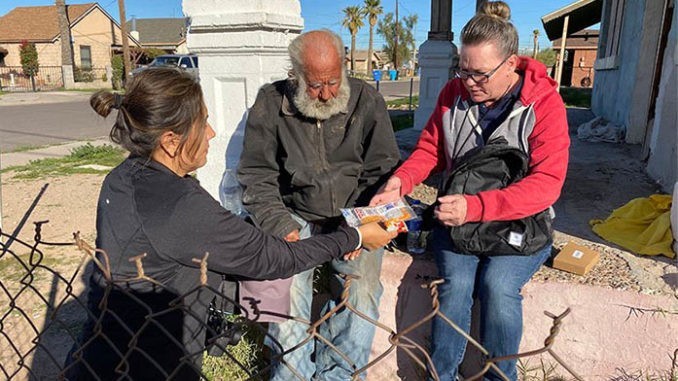
PHOENIX – Workers and volunteers combed washes, streets, park benches and public transit stops in every corner of Maricopa County on Tuesday, counting the number of people who are homeless.
One of those involved in the one-day count was Stefanie Smith, who works for the community group Native American Connections. She walked neighborhoods in Sunnyslope and downtown Phoenix, looking for people, taking down names and demographic information and asking question after question to better understand the resources needed to tackle a systemic issue.
“Is this the first time you’ve been homeless?”
“Have you been to any shelters recently?”
Those helping to conduct the annual Point-in-Time count people who are living in shelters or outside shelters to determine the scope of the needs. The 2019 count showed an uptick in people without shelter.
This year — for the first time — data was collected on a smartphone app. The information will be analyzed and sent to the federal Department of Housing and Urban Development, said Kelly Taft with the Maricopa Association of Governments.
When asked whether he had served in the military, Ralph James said yes.
He stood in a park wash in the Sunnyslope neighborhood in north central Phoenix, braced against the cold in a fleece jacket and cap embroidered with “9th Infantry, Vietnam Veteran.”
He talked about the dangers he encounters. He recently had his few belongings stolen.
“All my clothes and everything are gone, man,” James said. “This is the worst place I’ve ever been. I’m getting out of here. I’m going back to Lone Pines, California.”
Homelessness has become a chronic condition for many in the U.S. A report on last year’s count in Maricopa County shows 6,614 experienced homelessness on Jan. 21.
On Tuesday, volunteers started counting before sunrise, when the temperature was 42 degrees.
It’s been worse in previous years.
“There was one year when it was blistering cold outside and I was all layered up and we interviewed a man with a T-shirt, shorts and no shoes,” Taft said. “It broke my heart.”
Sam Taylor, who also works for Native American Connections, said workers and volunteers search strategically for people experiencing homelessness.
“They just want a place where they won’t be bothered – washes, parks, benches,” Taylor said. “They also go where there’s resources like shelters, public transit stops and hospitals. That’s where we go.”
This year marked the first year where the Point-in-Time traded their traditional clipboards for a digital survey and inserted the data into an app right on their phone as it was collected.
It’s more efficient than paper, Taft said.
What hasn’t changed is the urgency to help. Every person they encounter is offered a variety of resources – food, water, socks, toothbrushes, sanitizer, hats – even reading glasses.
One helper took the time to explain to Tony Cortes how to use the hand warmers they gave him. Overnight temperatures are expected to dip into the mid-40s.
Jésus Gonzalez was happy to have the help but was still reflective about his circumstances.
“It’s a terrible feeling to not have anywhere to go,” he said. “I used to have an apartment. I go to the shelter and it takes me an entire morning to shower. I used to be able to shower in 15 minutes and be ready to go.”
Gonzalez, who served in the Marine Corps and later worked as a plumber, said he suffers from diabetes and nerve damage. His medical issues mean he can’t work, he said.
After a few hours of counting, the workers and volunteers left their designated areas. After this week’s data is collected, the tentative analysis will be completed this spring, with the final data publicly released in August.
